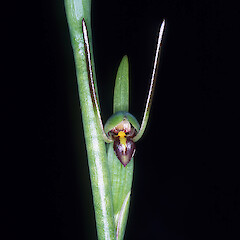Orthoceras novae-zeelandiae
Common name
horned orchid
Synonyms
Diuris novae-zeelandiae A.Rich., Orthoceras caput-serpentis Colenso, Orthoceras rubrum Colenso, Orthoceras solandri Lindl., Orthoceras strictum f. viride Hatch
Family
Orchidaceae
Flora category
Vascular – Native
Endemic taxon
Yes
Endemic genus
No
Endemic family
No
Structural class
Orchids
NVS code
The National Vegetation Survey (NVS) Databank is a physical archive and electronic databank containing records of over 94,000 vegetation survey plots - including data from over 19,000 permanent plots. NVS maintains a standard set of species code abbreviations that correspond to standard scientific plant names from the Ngä Tipu o Aotearoa - New Zealand Plants database.
ORTNOV
Chromosome number
2n = 42, 44
Current conservation status
The conservation status of all known New Zealand vascular plant taxa at the rank of species and below were reassessed in 2017 using the New Zealand Threat Classification System (NZTCS) – more information about this can be found on the NZTCS website. This report includes a statistical summary and brief notes on changes since 2012 and replaces all previous NZTCS lists for vascular plants.
Please note, threat classifications are often suggested by authors when publications fall between NZTCS assessment periods – an interim threat classification status has not been assessed by the NZTCS panel.
- Conservation status of New Zealand indigenous vascular plants, 2017 . 2018. Peter J. de Lange, Jeremy R. Rolfe, John W. Barkla, Shannel P. Courtney, Paul D. Champion, Leon R. Perrie, Sarah M. Beadel, Kerry A. Ford, Ilse Breitwieser, Ines Schönberger, Rowan Hindmarsh-Walls, Peter B. Heenan and Kate Ladley. Department of Conservation. Source: NZTCS and licensed by DOC for reuse under the Creative Commons Attribution 4.0 International licence.
2017 | Not Threatened
Previous conservation statuses
2012 | Not Threatened
2009 | Not Threatened
2004 | Not Threatened
Distribution
Endemic. New Zealand: North Island, South Island (mainly westerly and recorded as far south as Hokitika).
Habitat
Coastal to lower montane (up to 800 m a.s.l.). Usually in very sunny sites on open, free draining soils or clay banks with little associated taller vegetation. Often found in urban areas on mostly bare roadside cuttings.
Detailed description
Terrestrial, usually solitary, glabrous, perennial tuberous herb. Plant at flowering up to 900 mm tall. Tuber up to 50 × 10 mm ovoid, ovoid-ellipsoid. Stem fleshy dark green, red-green, to brown-green, stiffly erect, rather wiry, axis of raceme usually flexuous. Leaves fleshy, suberect to spreading, 10–20 × 3–6 mm, dark green, dark red-green to brown-green, basal third closely sheathing, linear-lanceolate to linear, channelled, apex acute. Inflorescence racemose up to 200 mm long, 2–12-flowered. Flowers more or less equidistant subtended by closely sheathing leaf-like bracts. Perianth colour variable, mostly green or red-green, sometimes greenish-yellow. Dorsal sepal uppermost, 10–15 × 9–14 mm, very broad, and arched over column, distinctly cucullate and deeply concave, subacute; lateral sepals 20–50 mm long, 0.5 mm diameter, narrow-linear, semi-terete, channelled, erect to divergent. Petals very short, narrow-oblong, flat, apex mostly notched, occasionally entire, more or less hidden under dorsal sepal. Labellum spreading, deflexed, firmly fleshy to almost coriaceous, green, red-green, yellow or black, trilobed, margins smooth, lateral lobes broad, oblique; mid-lobe larger, ovate; median callus yellow, restricted to near base, shortly conical with a thickened inturned, rounded apex, base of mid-lobe usually bearing two small calli. Column short, column-wings present as two lateral, linear processes, more or less papillose, almost as long as anther. Anther dorsal, taller than stigma, pollinia ill-defined, pollen granular. Stigma disc-shaped; rostellum prominent, acute.
Manaaki Whenua Online Interactive Key
Similar taxa
None.
Flowering
July–March
Flower colours
Green, Red/Pink
Fruiting
November–May
Propagation technique
Easily grown in a sunny, free draining soil. Excellent in pots. Should not be removed from the wild.
Etymology
orthoceras: Straight horn
novae-zeelandiae: Of New Zealand
Where To Buy
Not commercially available.
Taxonomic notes
The distinction between O. novae-zeelandiae and O. strictum R.Br. seems very slight and dubious. Orthoceras strictum is said to differ by its longer floral bract and more narrowly pointed labellum. Similar plants have been found in New Zealand, and there is often a gradation between broad and more narrowly pointed labellum apices present within populations.
Attribution
Description adapted from Moore and Edgar (1970).
References and further reading
Moore LB, Edgar E. 1970. Flora of New Zealand, Volume II. Indigenous Tracheophyta: Monocotyledones except Gramineae. Government Printer, Wellington, NZ. 354 p.

















